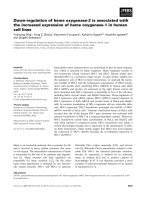Playing With the Boys - Why Separate is Not Equal in Sports
Bạn đang xem bản rút gọn của tài liệu. Xem và tải ngay bản đầy đủ của tài liệu tại đây (14.05 MB, 376 trang )
Playing with the Boys
This page intentionally left blank
eileen mcdonagh
laura pappano
Playing with the Boys
Why Separate Is
Not Equal in Sports
1
1
Oxford University Press, Inc., publishes works that further
Oxford University’s objective of excellence
in research, scholarship, and education.
Oxford New York
Auckland Cape Town Dar es Salaam Hong Kong Karachi
Kuala Lumpur Madrid Melbourne Mexico City Nairobi
New Delhi Shanghai Taipei Toronto
With offices in
Argentina Austria Brazil Chile Czech Republic France Greece
Guatemala Hungary Italy Japan Poland Portugal Singapore
South Korea Switzerland Thailand Turkey Ukraine Vietnam
Copyright # 2008 by Oxford University Press, Inc.
Published by Oxford University Press, Inc.
198 Madison Avenue, New York, NY 10016
www.oup.com
First issued as an Oxford University Press paperback, 2009
Oxford is a registered trademark of Oxford University Press
All rights reserved. No part of this publication may be reproduced,
stored in a retrieval system, or transmitted, in any form or by any means,
electronic, mechanical, photocopying, recording, or otherwise,
without the prior permission of Oxford University Press.
Library of Congress Cataloging-in-Publication Data
McDonagh, Eileen L.
Playing with the boys : why separate is not equal in sports /
Eileen McDonagh and Laura Pappano.
p. cm.
ISBN 978-0-19-538677-6 (pbk.)
1. Sports—Social aspects—United States. 2. Sex discrimination in sports—
United States. 3. Sex discrimination against women–United States.
I. Pappano, Laura, 1962– II. Title.
GV706.5.M3673 2008
306.4830973—dc22 2007018278
987654321
Printed in the United States of America
on acid-free paper
For Edward and Robert, and for Robert Edward,
and in memory of Carol Newsom—E.M.
For Tom, Olivia, Molly, and Donovan—L.P.
This page intentionally left blank
Contents
Preface ix
Acknowledgments xiii
one What’s the Problem? 1
two The Sex Difference Question 39
three Title IX: Old Norms in New Forms 77
four Sex-Segregated Sports on Trial 113
five Inventing Barriers 153
six Breaking Barriers 191
seven Pass the Ball 225
Notes 275
Index 335
A photo gallery appears after page 190
This page intentionally left blank
Preface
When radio shock jock Don Imus derided the Rutgers women’s
basketball team as ‘‘nappy-headed ho’s’’ the day after they had
played in the NCAA Division I championship game in April 2007,
capping an improbable season and play-off run with a powerful
showing of heart and skill, it wasn’t so shocking.
The comments sparked a firestorm. Sponsors deserted Imus. CBS
and MSNBC yanked his show. Pundits intoned. Sports radio hosts
went wild, some criticizing him but others defending him, claiming
the women had probably heard worse from the stands. What was
the big deal, anyhow?
Imus’s trash talk triggered expressions of public outrage about
the racist nature of his name-calling. Somewhere in the background,
with a little less fervor, we heard about gender.
It is easier to talk about race in sports. The deplorable treatment
faced by black male athletes like football talent Kenny Washington
and baseball star Jackie Robinson provides a clear wrong. We accept
that we should judge athletes based on their skill, character, and
performance—not the color of their skin.
On the other hand, female athletes, particularly successful wo-
men playing the ‘‘male’’ game of basketball, draw a muddier de-
fense. They may shoot from the perimeter, box out, pass and play
with a drive that makes watching a thrill, but there remains a
background buzz that challenges their identity: They can’t be real
women. At the heart of Imus’s remark—and the too faint defense of
women college players—was the notion that the serious, powerful
female athlete remains a social contradiction.
When we began work on this book more than six years ago,
probing the notion that sport is an essential tool for obtaining
gender equality in society, some met us with quizzical expressions.
Were we really serious? The very term ‘‘sex-segregated sports’’
struck some as odd. What did we mean?
As we probed further, however, unearthing parallels between
arguments against women’s access to workplace, higher education,
and voting rights and prevailing beliefs about female athletes and
their ‘‘place’’ in society, it became clear that the battle for gender
equality had reached a new frontier. Sports mattered to women’s
power off the field.
Sports, in other words, are not just for fun, are not just for guys,
are not just so much background yammering (though talk radio can
make it sound that way), but a social force that does not merely
reflect gender differences, but in some cases, creates, amplifies, and
even imposes them. What’s more, we found that it isn’t just habit
or preference that keeps males and females in their separate athletic
places; many recreational, educational, and professional sports
programs make it a legal requirement.
The ‘‘real’’ problem, we came to see, is the very notion of dividing
the athletic universe into ‘‘male sports’’ and ‘‘female sports,’’ which
has long seemed the most obvious and natural thing in the world.
And yet, when we began looking at the roots of this and the effects,
we found something surprising: Dividing sports by sex—segregating
organized athletics based on gender—doesn’t reliably reflect actual
physical differences between males and females at all. Rather, it
reflects antiquated social patterns and false beliefs. And what’s more,
it enforces, sometimes baldly, sometimes subtly, the notion that
men’s activities and men’s power are the real thing and women’s are
not. Women’s sports, like women’s power, are second-class.
The assumption that women are physically different from men
translates into the assumption that women are physically inferior to
men, which translates into the assumption that women couldn’t—
and hence shouldn’t—compete with men because that would spell
immediate injury to women, physically if not also psychologically.
x | Preface
The whole idea that one group is inherently better than another
also conflicts with the very American values that we each hold dear,
that is, the belief that each of us should be judged as an individual
and not defined by group membership. While we were well aware of
the benefits of Title IX, it became obvious that Title IX is not
enough. Yes, this law altered access to educational resources, in-
cluding sports, but it didn’t change the underlying structure of
the way society treated and viewed male and female athletes. By
condoning sex segregation in contact sports, Title IX ended up re-
inforcing the assumption that girls couldn’t—or shouldn’t—play
with the boys.
In fact, we found that it helps hold in place the stereotypical
notions of males and females. Eileen represents the pre–Title IX
generation and Laura a post–Title IX generation. No sports were
available to girls in Eileen’s high school, and so she shaped her
passion as a fan of horse racing and dogsled racing and embraced
outdoor activities, including hiking, which spurred her on treks
through the High Sierras and a climb of Mt. Kilimanjaro. Laura, on
the other hand, thanks to Title IX, was allowed to take middle
school wood shop, join the Danbury News-Times carrier baseball
league, and, with her sister, play midfield for the New Milford (CT)
town travel soccer team. And yet being ‘‘allowed’’ was different
from being welcomed and valued as an equal.
Title IX has gotten girls and women onto the playing field. But
the game itself remains off-kilter and poorly refereed. We need a
fresh way of thinking about organized sports that contributes to,
rather than distracts from, building real gender equality.
Days after Imus’s remarks, the Rutgers players found them-
selves giving a press conference in which their coach, C. Vivian
Stringer, painted them as accomplished students and aspiring mu-
sicians, doctors, veterinarians. The quest to reveal their nonathletic
interests was an apology of sorts, a means for ‘‘proving’’ they were
anything but ‘‘ho’s.’’ Many male college athletes at top Division I
basketball schools are not there for an education but for a boost into
the NBA. Ironically, no one refers to them as ‘‘ho’s.’’
xi
Preface |
This page intentionally left blank
Acknowledgments
This book began as a conversation in the corridors of the Murray
Research Center at the Radcliffe Institute for Advanced Study at
Harvard, and through these six years conversations have pushed this
book forward. Some of these talks have been formal: Thank you to
Wheelock College president Jackie Jenkins-Scott and athletic director
Diana Cutaia, as well as University of Lowell professor Jeffrey
Gerson. Bob Davoli generously provided us with a practice field in the
business community where we could test our thesis in the company
of unusually tough-minded (if not macho) audiences. Many pro-
fessional political science associations over the years include d us on
panels where we benefited enormously from discussants’ construc-
tive criticism; political scientist Kristin Goss at Duke University in-
corporated our work into her courses even before its publication,
giving us a prescient preview o f student’s-eye views. Harv a rd U ni-
versity’s Government Department, American Politics Workshop,
was an inv a luable forum for trial runs before going into print.
The Boston Globe Magazine, including former editors John
Koch and Nick King, as well as current editor in chief Doug Most,
gave our argument early airings. New York Times Education Life
editor Jane Karr made room for a sports story in her section. We
gained from small meetings and structured conversations with Bill
Littlefield, Peter Roby, Cathy Inglese, and Barbara Lee.
This book has also served as the fuel and beneficiary of more
dinner party debates than either of us can list here. Special thanks to
those who prodded and encouraged us, who never failed to ask,
‘‘How’s the book going?’’ Many have offered valuable feedback or
opened doors f or us, especially Mandy Bass, And r ew Martin, Peter
Karoff, Paul Friedberg, Andrea Kelley, Eric Schwarz, Maureen Cof -
fey, Chuck Agosta, Lucy McQuilken, Je rry Grady, Evelyn Kramer,
Davi Ellen Chabner, Larry Shulman, Howard Weinstein, Mary Wolf,
David Davoli, and Steven George. Athletes Karen Smyers, Emily
Watts, Bobbi Gibb, Margaret Murdock, Nikki Darrow, Kim Salma,
Shelley Looney, and Ryan Jones generously shared their experiences,
as did physicians Dr. Bert Zarins, Dr. Carol Otis, and Dr. Arthur
Boland.
In addition, we extend our deepest thanks and gratitude to those
who plowed through earlier versions of our manuscript, sometimes
in the context of professional academic meetings, and always of-
fering invaluable criticism and advice. To Wade Woodson we are
especially indebted, as well as to Lee Ann Banaszak, Nico Cornell,
Bob Davoli, Sheila Fiekowsky, Kristin Goss, Mary Katzenstein,
Edward Price, Robert Price, Stephano Quatrano, Cindy Rosenthal,
Kay Schlozman, Shauna Shames, and Sidney Verba.
We received research help from many quarters, including the
Smith College Library archives, The White House Project,
Northeastern University, papers from the National Organization
for Women, Julie Masters at Scholastic, Inc., and USA Wrestling.
Special thanks to the Schlesinger Library at the Radcliffe Institute
for Advanced Study at Harvard, particularly to Diana Carey, and to
Nicole Zarrett and Leanne Doherty, who were there encouraging us
at the start of this enterprise. We also thank Anne Colby for her
support while we were at the Murray Research Center, and later
Annemette Sørensen and Marty Mauzy. In addition, Eileen
McDonagh wishes to offer special thanks to Drew Gilpin Faust for
providing an affiliate appointment at the Radcliffe Institute for
Advanced Study, which greatly facilitated this project. Eileen also
thanks Gary King for appointing her as a Visiting Scholar at the
Institute for Quantitative Social Science (IQSS) at Harvard Univer-
sity, an invaluable community of scholars. We also thank research
assistants who were crucial for the completion of this project, in-
cluding Lauren Ernst, Michele Frazier, Anne Gue`vremont, Michele
xiv | Acknowledgments
Hearty, Deanne Kallgren, Elizabeth Pipkin, Efrat Procaccia, Rain
Robertson, Shauna Shames, and Greg Skidmore. In addition, we
thank Robert Price and Shauna Shames for editorial assistance.
This book also owes a large debt to those journalists and aca-
demics who have wrangled with issues of gender and sports. We are
especially grateful for the work of Deborah Brake, Susan Cahn,
Shirley Castelnuovo, Mary Jo Festle, Lynda Ransdell, Sharon
Guthrie, Allen Guttmann, John R. Thelin, Elliot J. Gorn, Warren
Goldstein, Christine Brennan, Susan Jennings, Jere Longman, Se-
lena Roberts, William C. Rhoden, Welch Suggs, Karen Tokarz,
Joseph B. Treaster, and Diane Heckman.
Writing a book is one thing, publishing it is another, and we are
the beneficiaries of the continuous contributions of talented,
thoughtful, and dedicated individuals at Oxford University Press.
Our editor, David McBride, embraced the project and brought his
sharp mind and sport-world fluency to the manuscript. This book
would not exist without the foresight and enthusiasm of Dedi
Felman, whose initial guidance, tough questions, and support were
invaluable. Oxford vice president and publisher Niko Pfund was
engaged from the start; Laura Lewis’s careful and thoughtful work
raised critical questions. We are indebted to many others at Oxford,
including Brendan O’Neill.
Finally, each of us extends our deepest thanks to our families.
Laura Pappano directs special credit to Tom Lynch, whose prodigious
sports knowledge has been invaluable, and who has approached this
project with as much passion, support, and information (thank you
for every rumpled news clipping and anecdote) as any writer or
partner dare hope for. Olivia, Molly, and Donovan have lived the
mantra of gender equality and even helped with research. There is no
family member who has not made a contribution: Thanks to JoAnne,
Robert, Nancy, Tom, Barbara, Dante, Ellen, Margaret, Adnan, An-
drea, S pence, Christopher, Ag ne s, Susan, Derek, and Nancy. Eileen
McDonagh also counted on her family and on Lesko, a very special
brava hund always there for her, to see her through this project. She
directs her love and thanks to Edward Price, Ellen Price, and Zachary
Price, to Robert Price and Alice Bierhorst, and to Bob Davoli whose
loyalty and enthusiasm for it all carry the day.
xv
Acknowledgments |
This page intentionally left blank
Playing with the Boys
This page intentionally left blank
1
What’s the Problem?
Egalitarianism is the philosophical foundation of our political
process.
—Hoover v. Meiklejohn
1
Sports Matter
When two former U.S. presidents, Bill Clinton and George H. W.
Bush, sat down the evening of February 6, 2005, at the Fox Network
sports desk, they delivered more than the planned message. Osten-
sibly the two appeared on the Super Bowl pregame show to win
support for tsunami relief efforts. However, in choosing this event
as their venue, they embraced an unabashed cultural and political
fact: Sports matter.
2
Athletic events, they confirmed, are more than entertainment, ex-
ercise, orpastime.Sports—football and the Super Bowl in particular—
provide one of the largest and most important stages in American
society. Some 86 million U.S. households tuned in to watch Super
Bowl XXXIX. By contrast, four days earlier just 38.4 million tuned in
to President George W. Bush’s State of the Union Address.
3
The NFL
may be among the most superbly packaged and marketed athletic
products in the world, but the ease with which politics, power, and
money intermingle with organized sports is more than a good pitch.
The connections run deep.
4
Some sociologists argue that ‘‘sports have
replaced formal religion as a dominant force in the lives of many
Americans.’ ’
5
And ineducational contexts, as law scholar Julia Lamber
notes, the purpose of sports ‘‘is for students to learn the kinds of
discipline, cooperation, and ability to meet challenges that often
produce success in later public and private life.’’
6
As political activist Barbara Lee notes, ‘‘When a popular male
athlete retires, he’s often encouraged to run for office. When John
Elway retired from the Broncos, people wanted him to run for Con-
gress. When Forty-Niners’ Steve Young retired, people encouraged
him to run for the Senate.’’
7
Hence it is no accident that former
Major League Baseball players, ex-football players, and retired NBA
gamers serve in Congress. When President George W. Bush (former
Little Leaguer and baseball team owner) delivered his 2004 State
of the Union Address, media outlets made much ado about New
England Patriots quarterback Tom Brady appearing in Mrs. Laura
Bush’s box. A few noted the attendance of WNBA player Tamika
Catchings.
Sports and Masculinity
Athletics are a comfortable companion to power. The easy chemistry
between sports, politics, and business, as political scientist Varda
Burstyn argues, has led to natural alliances.
8
As Michael Messner
notes, they all provide a forum for public displays of masculinity.
9
Success in athletics, as in politics and business, defines what it is to
be ‘‘male’’ in our society. Organized sports enforce a male power
structure that reaches far beyond the field.
10
Organized sports sup-
port a form of sex segregation that permeates nearly every aspect
and intersection of athletic and popular culture. Courts pronounce
athletes individuals, but practice and institutional rules first sort
players as male or female. Some individuals courageously challenge
sex discrimination in sports, but most accept the status quo.
11
Such acceptance is not without consequence. Yes, Tamika
Catchings attended the State of the Union Address, but her presence,
in contrast to Brady’s, lacked a broader context. There was no con-
fusion about the meaning of Brady’s attendance, either the cachet of
2 | Playing with the Boys
being invited or the value to President Bush in hosting a two-time
Super Bowl MVP known for handling clutch situations with clear-
headed cool.
Sports and Sex Equality
This book addresses the issue of sex equality in the context of sports.
We live in a society in which key elements are gendered as male.
12
Winning is male. Power is male. Money is male. Physical dominance
is male. And big-time Las Vegas–lined, network-covered, sold-out-
venue, sponsor-rich sports are male. We must recalibrate this sys-
tem. Athletics should be gender-neutral, a human activity and not
a pumped-up, artificial rendition of men’s strength and women’s
weakness as a definition of sex identity.
13
Many see sports as a static system reflecting social and gender
realities rather than constructing them. After all, it has been drilled
into our heads that female athletes are not as good as male athletes,
that female sports are less interesting, that female sporting events
are less worthy of promotion or public interest. Open any sports
page or tune in to any television news sports segment in the country
and see such beliefs confirmed.
This state of affairs has sprung from the same history of bias that
pronounced women out of place in jobs other than secretary, nurse,
or teacher. It has sprungfrom times when physicians insisted women
are not physically strong enough to handle the stress of higher
education, that letting women use their brains too much shrinks
their uteruses, rendering them infertile.
14
This bias was born from
the gut anger some express at the notion of women serving in the
military, particularly in combat. No wonder children once giggled
at the very idea of a woman firefighter or police officer. In other
words, biases that once seemed untouchable—biases based on beliefs
about female physical limitations—now appear absurd.
Athletics Is Not a Special Case
The culture and the structure governing organized sports should not
exist apart from the fairness and equality mandated in other sectors
of American life. Hold organized sports accountable in this way, and
a system out of balance is revealed, one in which male superiority
3
What’s the Problem? |
is not merely presumed but artificially constructed and enforced,
not only by social norms but also by legal ones.
15
What is more,
these patterns are dominant not only in the way sports are organized
for the very young but also, as Maree Boyle and Jim McKay note,
for the elderly.
16
Thus it is time to examine sports in the context of
the American heritage of egalitarian values and constitutional prin-
ciples.
17
For this reason, we have written a different kind of book
about sports and gender. It is about what is recognized but rarely
examined: how athletics shape and perpetuate stereotypical gender
roles that limit women’s social, economic, and political opportuni-
ties, thereby maintaining women’s inequality in American society
compared to men.
Intersectionality
Taken together, human beings constitute an intersection of many
ascriptive characteristics acquired at birth, such as their race, class,
religious background, language orientation, nationality, historical
time period of birth, and, of course, their sex. The complexities of the
way ascriptive characteristics interact socially, economically, and
politically make it dangerous to single out just one, such as sex, as
the definition of a problem. This is because whatever a person ex-
periences due to one ascriptive characteristic, such as sex, is modified
greatly by all the other characteristics, such as race, class, nationality,
and so on. As legal scholar Rhonda Reaves notes, African American
women, for example, often experience discrimination because of
their gender and their race. Consequently they are particularly vul-
nerable to the harm of sexual harassment in sports contexts where
they are coached by white males.
18
Consider the sexist and racial slurs directed at the Rutgers Uni-
versity women’s basketball team by Don Imus, one of the most
influential and financially lucrative ‘‘pitchmen in the history of
radio, if not broadcasting.’’
19
Although famous for ridiculing the
elite and the powerful in the celebrity world of politics and enter-
tainment, he struck a low blow when he mocked and degraded the
mostly African American women basketball players as ‘‘nappy-
headed ho’s.’’
20
Clearly racism was intersecting with sexism in
his attack on these 18-, 19 -, and 20-year-old women. The outrage
generated by the debacle was more than warranted. As Essence
4 | Playing with the Boys
Carson, captain of the Rutgers basketball team, explained, ‘‘It is
more than a game of basketball as a society, we’re trying to
grow and get to the point where we don’t classify women as hos
and we don’t classify African-American women as nappy-headed
hos.’’
21
Exactly.
Thus we wish to establish at the outset that we are cognizant of
the need for an appreciation of the intersectionality that is the re-
ality for all human beings.
22
However, we also see another reality,
namely, the way assumptions about women’s inferiority to men in
athletic endeavors cuts across all other ascriptive characteristics. All
women are assumed to be athletically inferior to all men, whether
the comparison is between or within ascriptive groups. Thus, for
example, African American women are viewed as athletically infe-
rior to African American male athletes as well as white male ath-
letes; women from Kenya are assumed to be inferior athletes
compared to men from Kenya as well as American men; French-
speaking women athletes in Quebec are assumed to be athletically
inferior to male French-speaking athletes in Quebec as well as all
other male athletes from everywhere.
Something about ‘‘Sex’’
Thus we argue there is something about sex difference in relation to
assumptions about athletic prowess that requires particular atten-
tion in spite of the intersectionality principle. No matter how valu-
able and crucial it is to understand the way sex, race, class, and so on,
work together to set parameters for life opportunities and experi-
ences, we also point to the way ‘‘sex difference’’ is assumed by most
to be the most determinant ascriptive attribute that accounts for
athletic talent and performance. For example, is it likely that Don
Imus would have made his racialized remarks about Rutgers’
women’s basketball team if they had been men? Would he have
called a male basketball team a bunch of ‘‘nappy-headed _____ [fill
in the blank]’’? No, we can assume that it was the women’s sex that
first caught his attention and then their race. This is not to say that
the racial component of his sexism is unimportant or irrelevant to an
analysis of sex discrimination in sports. Rather, it is merely to as-
sume that the starting point for an analysis of sex-segregated sports
policies and the harm they impose on all women is assumptions
5
What’s the Problem? |
about sex difference first, as a foundation for an examination of how
other ascriptive characteristics, such as race, nationality, and dis-
ability, necessarily intersect with sex difference discrimination. A
full analysis of the intersectionality dimension of sex discrimina-
tion in sports would go beyond the scope of this book. Our aim is to
begin the conversation about intersectionality in sports by ad-
dressing the foundation of that intersectionality: sexism in sports in
general and coercive sex segregation as an underrecognized form of
sexism in particular.
23
Thus the goal of this book is to address and challenge the way sex
difference is tied to the myth of female inferiority and its corollary,
a history that prevented women from playing hard or even com-
peting at all—whatever their race, class, and so on. In the case of the
United States, this book applauds Title IX’s vital and pioneering
push but draws attention to its failure to challenge adequately the
assumption of women’s athletic inferiority, which still pervades the
recreational, educational, and professional sports arenas.
Time to Challenge the Way We Think about Sports
This book, therefore, is about how sports matter in American so-
ciety and how sports do—or do not—promote women’s equality.
These are relevant questions regardless of one’s predilection toward
sports. Whether you are passionate about sports and believe athletics
matter—or matter too much—this book aims to address everyone
by addressing the meaning of sports in American society. We aim
for this book to serve as a field guide for understanding a funda-
mental principle: if women cannot compete fairly on the field, they
cannot compete fairly off it, either. As long as the phrase ‘‘you play
like a girl’’ remains an insult, female abilities are undervalued—for
all women, whatever their race, class, or other birth characteristics.
This book challenges how we think about organized sports, as
participants, parents, and fans. Athletics are a visible part of Amer-
ican culture and it’s tempting to accept what is presented. That is
why it’s critical to put sports into a legal, historical, and social con-
text and to challenge the gut assumption that Title IX provided a fix
and a level playing field for females in athletics. Yes, we can credit
Title IX with getting more women involved in sports programs.
However, as sports scholars Barrie Houlihan and Anita White argue,
6 | Playing with the Boys









